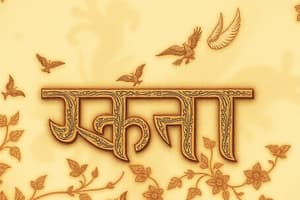Podcast
Questions and Answers
What is the writing system used for Hindi?
What is the writing system used for Hindi?
- Latin script
- Devanagari script (correct)
- Cyrillic script
- Arabic script
Which of the following is considered a dialect of Hindi?
Which of the following is considered a dialect of Hindi?
- Bhojpuri (correct)
- Swahili
- Mandarin
- German
What is the typical sentence structure of Hindi?
What is the typical sentence structure of Hindi?
- Subject-Object-Verb (SOV) (correct)
- Verb-Subject-Object (VSO)
- Object-Subject-Verb (OSV)
- Subject-Verb-Object (SVO)
Which language family does Hindi belong to?
Which language family does Hindi belong to?
Which of the following is a common challenge in learning Hindi for non-native speakers?
Which of the following is a common challenge in learning Hindi for non-native speakers?
Flashcards are hidden until you start studying
Study Notes
Overview of Hindi
- Language Family: Indo-Aryan, part of the Indo-European family.
- Region: Predominantly spoken in India and Nepal.
- Official Status: One of the two official languages of the Government of India (the other being English).
Script
- Writing System: Devanagari script.
- Characteristics:
- Consists of 11 vowels and 33 consonants.
- Written from left to right.
Dialects
- Varieties:
- Standard Hindi: Based on the Khariboli dialect.
- Other Dialects: Bhojpuri, Awadhi, Braj, and others.
Vocabulary
- Influences:
- Borrowed words from Sanskrit, Persian, Arabic, English, and regional languages.
- Loanwords: Significant number of English words integrated into everyday usage.
Grammar
- Morphology: Inflectional language with a rich system of conjugation and declension.
- Sentence Structure: Typically Subject-Object-Verb (SOV) order.
- Tenses: Present, past, and future with various aspects.
Phonetics
- Consonants: Includes aspirated and unaspirated sounds.
- Vowels: Short and long vowels that can change the meaning of words.
Cultural Significance
- Literature: Rich literary tradition, including poetry, novels, and plays.
- Media: Widely used in Bollywood films, music, and television.
Usage
- Speakers: Over 600 million speakers worldwide.
- Status in Education: Taught as a first or second language in schools across India.
Modern Developments
- Technology: Increasing use in digital communications, social media, and software applications.
- Standardization: Continuous efforts to standardize grammar and vocabulary usage.
Learning Hindi
- Resources: Language courses, online tutorials, and language exchange programs.
- Challenges: Pronunciation and script can be difficult for non-native speakers.
Overview of Hindi
- Language belongs to the Indo-Aryan group, a branch of the Indo-European language family.
- Mainly spoken in India and Nepal, with extensive regional distribution.
- Hindi holds official status as one of India's two national languages, alongside English.
Script
- Utilizes the Devanagari writing system, known for its distinct visual characters.
- Contains 11 vowels and 33 consonants, providing a comprehensive sound system.
- The script is read from left to right, influencing writing style and layout.
Dialects
- Standard Hindi is derived from the Khariboli dialect, serving as the basis for formal communication.
- Numerous regional dialects exist, including Bhojpuri, Awadhi, and Braj, each with unique linguistic features.
Vocabulary
- Hindi vocabulary is enriched by influences from various languages such as Sanskrit, Persian, Arabic, and English.
- A significant amount of English terminology has become common in everyday Hindi usage.
Grammar
- Hindi is characterized as an inflectional language, rich in noun and verb forms through conjugation and declension.
- The typical sentence structure follows a Subject-Object-Verb (SOV) order, distinct from the Subject-Verb-Object (SVO) order found in English.
- Tenses in Hindi include present, past, and future, encompassing multiple aspects to convey meaning.
Phonetics
- The consonant system includes both aspirated (breathy) and unaspirated sounds, which are phonemically significant.
- Vowel distinctions include both short and long variants, which can entirely alter word meanings.
Cultural Significance
- Hindi boasts a rich literary heritage, featuring diverse genres such as poetry, novels, and plays that reflect cultural narratives.
- The language enjoys widespread use in Bollywood, impacting music, film, and television, thus contributing to contemporary culture.
Usage
- Approximately 600 million speakers globally, making it one of the most spoken languages in the world.
- Hindi is commonly taught as both a first and second language in Indian educational institutions, fostering its presence among younger generations.
Modern Developments
- Increasingly utilized in digital communication contexts, including social media and mobile applications, reflecting modern user habits.
- Efforts are underway to standardize Hindi grammar and vocabulary, facilitating clearer communication and understanding.
Learning Hindi
- Varied resources available for learners, including language courses, online tutorials, and exchange programs to practice conversational skills.
- Non-native speakers may encounter challenges, particularly with pronunciation and mastering the Devanagari script.
Studying That Suits You
Use AI to generate personalized quizzes and flashcards to suit your learning preferences.




